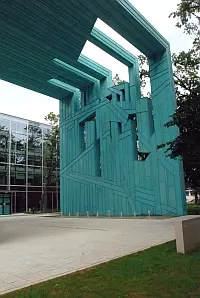 The Faculty of Science and Technology in Debrecen has been an individual Faculty since 1949. The ideology and practical work carried out at the Calvinist College of Debrecen has always provided outstanding examples of how much Debrecen has participated in the cultivation of sciences at the level of contemporary knowledge. Already in 1558 a herbarium collection was made (by Péter Méliusz-Juhász) and printed, and in 1577 Debrecener Arithmetics, the first mathematical work written in Hungarian was published in Debrecen. There was another book on mathematics from the 18th century written by György Maróthi that saw three publications. The physics laboratory was set up as early as the early 1700s and was continuously expanded with more modern equipment; its wide range of laboratory apparatus is now on display in the school museum. It was also in Debrecen that in 1750 the first chemistry course in Hungary was held by a polymath (István Hatvani) known for his ‘perplexing’ physical experiments. Another first was when in 1823 the College started chemistry instruction in Hungarian (professor Ferenc Kerekes). Works of brilliant Debrecen scholars (József Csapó. Sámu-el Diószegi, Mihály Fazekas) were significant milestones in the development of the discipline of botany in Hungary as well as an aid in the tuition of zoology. Geosciences were taught from the very beginning; maps were introduced in the teaching of geography and history, and there is evidence of astronomy instruction as early as 1665. By the second half of the 19th century, however, sciences, unlike humanities, had lost some of their significance, and the implications of this regrettable fact were also manifest in the foundation of the University of Debrecen.
The Faculty of Science and Technology in Debrecen has been an individual Faculty since 1949. The ideology and practical work carried out at the Calvinist College of Debrecen has always provided outstanding examples of how much Debrecen has participated in the cultivation of sciences at the level of contemporary knowledge. Already in 1558 a herbarium collection was made (by Péter Méliusz-Juhász) and printed, and in 1577 Debrecener Arithmetics, the first mathematical work written in Hungarian was published in Debrecen. There was another book on mathematics from the 18th century written by György Maróthi that saw three publications. The physics laboratory was set up as early as the early 1700s and was continuously expanded with more modern equipment; its wide range of laboratory apparatus is now on display in the school museum. It was also in Debrecen that in 1750 the first chemistry course in Hungary was held by a polymath (István Hatvani) known for his ‘perplexing’ physical experiments. Another first was when in 1823 the College started chemistry instruction in Hungarian (professor Ferenc Kerekes). Works of brilliant Debrecen scholars (József Csapó. Sámu-el Diószegi, Mihály Fazekas) were significant milestones in the development of the discipline of botany in Hungary as well as an aid in the tuition of zoology. Geosciences were taught from the very beginning; maps were introduced in the teaching of geography and history, and there is evidence of astronomy instruction as early as 1665. By the second half of the 19th century, however, sciences, unlike humanities, had lost some of their significance, and the implications of this regrettable fact were also manifest in the foundation of the University of Debrecen.
The University of Debrecen was founded in 1912 with five Faculties. The Faculties of Law, Theology and Humanities developed directly from the three academic divisions of the College -- and thus could start tuition immediately – but the conception of universitas involved an inherent need for the creation of the Faculties of Science and Medicine. While the Faculty of Medicine – along with the clinics – was brought to life by social demand shortly after the university was founded, the Faculty of Sciences was built up slowly. Certainly, the Faculty of Medicine had physics and chemistry departments, but other science departments such as botany, zoology, geography, mineralogy and mathematics were part of the Faculty of Humanities. This meant that science teacher training programmes also started at the University in the 1920s. Probably the only positive element in the authoritarian disintegration of the university in 1949/50 was the foundation of an independent Faculty of Science.
In the 60 years after its foundation, the Faculty of Science at the University of Debrecen has made considerable contributions to the development and expansion of fields of scientific research and education. Due to this progress the Faculty has 27 departments and departmental units teaching 4000 students.